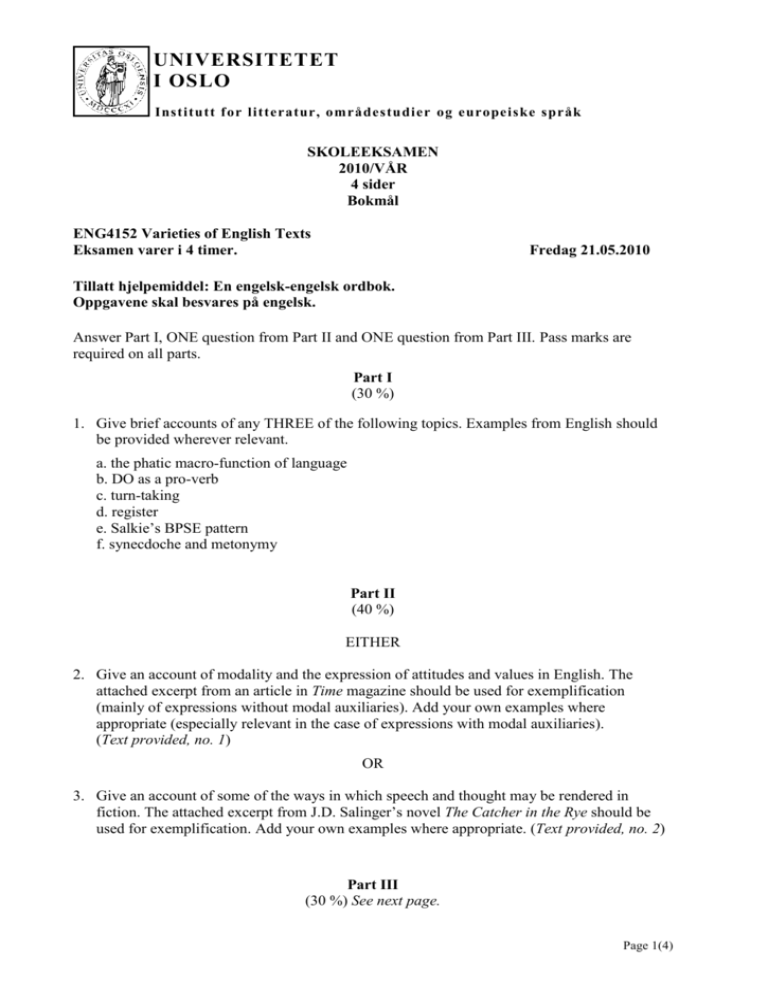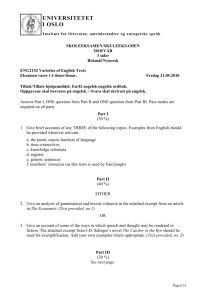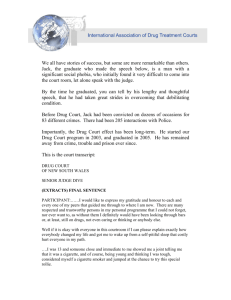Spring 2010 - Universitetet i Oslo
advertisement

UNIVERSITETET I OSLO Institutt f or litteratur, områdestudier og europeiske språk SKOLEEKSAMEN 2010/VÅR 4 sider Bokmål ENG4152 Varieties of English Texts Eksamen varer i 4 timer. Fredag 21.05.2010 Tillatt hjelpemiddel: En engelsk-engelsk ordbok. Oppgavene skal besvares på engelsk. Answer Part I, ONE question from Part II and ONE question from Part III. Pass marks are required on all parts. Part I (30 %) 1. Give brief accounts of any THREE of the following topics. Examples from English should be provided wherever relevant. a. the phatic macro-function of language b. DO as a pro-verb c. turn-taking d. register e. Salkie’s BPSE pattern f. synecdoche and metonymy Part II (40 %) EITHER 2. Give an account of modality and the expression of attitudes and values in English. The attached excerpt from an article in Time magazine should be used for exemplification (mainly of expressions without modal auxiliaries). Add your own examples where appropriate (especially relevant in the case of expressions with modal auxiliaries). (Text provided, no. 1) OR 3. Give an account of some of the ways in which speech and thought may be rendered in fiction. The attached excerpt from J.D. Salinger’s novel The Catcher in the Rye should be used for exemplification. Add your own examples where appropriate. (Text provided, no. 2) Part III (30 %) See next page. Page 1(4) Part III (30 %) EITHER 4. Give an analysis of grammatical and lexical cohesion in the attached excerpt from an article in The Economist. (Text provided, no. 3) OR 5. Give an account of Biber’s attempt to classify English text types. In your answer you should explain the results of Biber’s factor analysis as they emerge from the attached table from his article. (Text provided, no. 4) Text provided, no. 1 Postcard: Halden Norway Builds the World's Most Humane Prison 3 By the time the trumpets sound, the candles have been lit and the salmon platters garnished. Harald V, King of Norway, enters the room, and 200 guests stand to greet him. Then a chorus of 30 men and women, each wearing a blue police uniform, launches into a spirited rendition of "We Are the World." 6 This isn't cabaret night at Oslo's Royal Palace. It's a gala to inaugurate Halden Fengsel, Norway's newest prison. Ten years and 1.5 billion Norwegian kroner ($252 million) in the making, Halden is spread over 75 acres 9 (30 hectares) of gently sloping forest in southeastern Norway. The facility boasts amenities like a sound studio, jogging trails and a freestanding two-bedroom house where inmates can host their families during overnight visits. Unlike many American prisons, the air isn't tinged with the smell of sweat and urine. 12 Instead, the scent of orange sorbet emanates from the "kitchen laboratory" where inmates take cooking courses. "In the Norwegian prison system, there's a focus on human rights and respect," says Are Hoidal, the prison's governor. "We don't see any of this as unusual." 15 Halden, Norway's second largest prison, with a capacity of 252 inmates, opened on April 8. It embodies the guiding principles of the country's penal system: that repressive prisons do not work and that treating prisoners humanely boosts their chances of reintegrating into society. "When they arrive, many of them 18 are in bad shape," Hoidal says, noting that Halden houses drug dealers, murderers and rapists, among others. "We want to build them up, give them confidence through education and work and have them leave as better people." 21 The cells rival well-appointed college dorm rooms, with their flat-screen TVs and minifridges. Designers chose long vertical windows for the rooms because they let in more sunlight. There are no bars. Every 10 to 12 cells share a living room and kitchen. With their stainless-steel countertops, wraparound sofas and 24 birch-colored coffee tables, they resemble Ikea showrooms. Halden's greatest asset, though, may be the strong relationship between staff and inmates. Prison guards don't carry guns — that creates unnecessary intimidation and social distance — and they routinely eat 27 meals and play sports with the inmates. "Many of the prisoners come from bad homes, so we wanted to create a sense of family," says architect Per Hojgaard Nielsen. Half the guards are women — Hoidal believes this decreases aggression — and prisoners receive questionnaires asking how their experience in 30 prison can be improved. There's plenty of enthusiasm for transforming lives. "None of us were forced to work here. We chose to," says Charlott-Renee Sandvik Clasen, a music teacher in the prison and a member of Halden's security33 guard chorus. "Our goal is to give all the prisoners — we call them our pupils — a meaningful life inside these walls." It's warmth like that, not the expensive television sets, that will likely have the most lasting impact. (Adapted from Time magazine) Page 2(4) Text provided, no. 2 1 ‘Hey,’ Stradlater said. ‘Wanna do me a big favour?’ ‘What?’ I said. Not too enthusiastic. He was always asking you to do him a big favour. You take a very handsome guy, or a guy that thinks he’s a real hot-shot, and they’re always asking you to do them a big favour. Just because they’re crazy about 5 themself, they think you’re crazy about them, too, and that you’re just dying to do them a favour. It’s sort of funny, in a way. ‘You goin’ out tonight?’ he said. ‘I might. I might not. I don’t know. Why?’ ‘I got about a hundred pages to read for History for Monday,’ he said. ‘How about 10 writing a composition for me, for English? I’ll be up the creek if I don’t get the goddam thing in by Monday. The reason I ask. How ’bout it?’ It was very ironical. It really was. ‘I’m the one that’s flunking out of the goddam place, and you’re asking me to write you a goddam composition,’ I said. 15 ‘Yeah, I know. The thing is, though, I’ll be up the creek if I don’t get it in. Be a buddy. Be a buddyroo. Okay?’ I didn’t answer him right away. Suspense is good for some bastards like Stradlater. ‘What on?’ I said. ‘Anything. Anything descriptive. A room. Or a house. Or something you once lived in 20 or something – you know. Just as long as it’s descriptive as hell.’ He gave out a big yawn while he said that. (From J.D. Salinger, The Catcher in the Rye) Text provided, no. 3 Inspector Norse Scandinavian crime fiction: Why are Nordic detective novels so successful? 3 THE neat streets of Oslo are not a natural setting for crime fiction. Nor, with its cows and country smells, is the flat farming land of Sweden’s southern tip. And Reykjavik, Iceland’s capital, is now associated more with financial misjudgment than gruesome murder. Yet in the past decade Nordic crime writers 6 have unleashed a wave of detective fiction that is right up there with the work of Dashiell Hammett, Patricia Highsmith, Elmore Leonard and the other crime greats. Nordic crime today is a publishing phenomenon. Stieg Larsson’s Millennium trilogy alone has sold 27m copies, its publishers’ latest figures 9 show, in over 40 countries. The release this month in Britain and America of “The Girl with the Dragon Tattoo”, the film of the first Larsson book, will only boost sales. The transfer to the screen of his sprawling epic (the author died suddenly in 2004 just as the trilogy was 12 being edited and translated) will cement the Nordics’ renown. The more unruly subplots have been eliminated, leaving the hero, a middle-aged financial journalist named Mikael Blomkvist (Michael Nyqvist), and an emotionally damaged computer hacker, Lisbeth Salander (Noomi Rapace, pictured 15 above), at the centre of every scene. The small screen too has had a recent visit from the Swedish police. Starting in 2008, British television viewers have been treated to expensive adaptations of the books of Henning Mankell, featuring Kenneth Branagh as Kurt Wallander. The BBC series has reawakened 18 interest in Mr Mankell’s nine Wallander books, which make up a large slice of his worldwide sales of 30m in 40 languages. Larsson and Mr Mankell are the best-known Nordic crime writers outside the region. But several others 21 are also beginning to gain recognition abroad, including K.O. Dahl and Karin Fossum from Norway and Ake Edwardson and Hakan Nesser of Sweden. Iceland, a Nordic country that is not strictly part of Scandinavia, boasts an award winner too. Arnaldur Indridason’s “Silence of the Grave” won the British 24 Crime Writers’ Association Gold Dagger award in 2005. “The Devil’s Star” by a Norwegian, Jo Nesbo, is published in America this month at the same time as a more recent novel, “The Snowman”, is coming out in Britain. A previous work, “Nemesis”, was nominated for the prestigious Edgar Allan Poe crime27 writing award, a prize generally dominated by American authors. (Adapted from The Economist) Page 3(4) Text provided, no. 4 (From Douglas Biber, ‘Spoken and written textual dimensions in English: resolving the contradictory findings’) Page 4(4)









